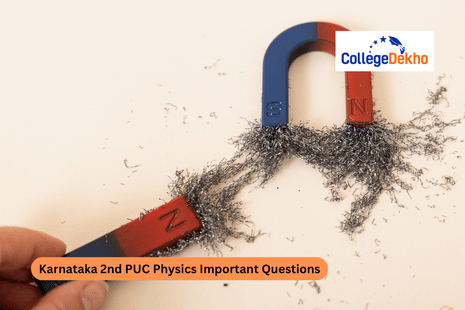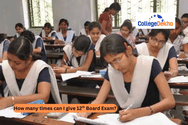- Karnataka 2nd PUC Physics Important Questions 2026 of 1 Mark
- Karnataka 2nd PUC Physics Important Questions 2026 of 2 Marks
- Karnataka 2nd PUC Physics Important Questions 2026 of 3 Marks
- Karnataka 2nd PUC Physics Important Questions 2026 of 5 Marks
- Which chapters have more weightage in Karnataka 2nd PUC Physics?
- Faqs


Never Miss an Exam Update
Karnataka 2nd PUC Physics Important Questions 2026 is a good source of revision. You can learn a lot about the structure of the different types of questions that will be asked during the main board exams by solving these important questions. The Physics paper will be conducted for 70 marks. The question paper will consist of MCQs, very short answer type questions, short answer type questions, and long answer questions. Below, we have curated important questions from each chapter, categorized by weightage of marks. Make sure to also pick up the
Karnataka 2nd PUC Physics Model Paper 2025-26
for revision, as these papers will help you check the level of preparation and you can work on the weaker areas. Check out the Karnataka 2nd PUC Physics Important Questions 2026 here.
Also Check
Karnataka 2nd PUC Physics Syllabus 2026
Karnataka 2nd PUC Physics Important Questions 2026 of 1 Mark
A total of 15 MCQs will be included in the Karnataka 2nd PUC Physics paper. You can check out the most important MCQs that may be asked during the board exams below. These questions are created based on the model test papers and the Karnataka 2nd PUC Physics Previous Year Question Paper.
Question 1: A moving coil galvanometer can be converted into a voltmeter by connecting
(A) a low resistance in parallel with galvanometer.
(B) a low resistance in series with galvanometer.
(C) a high resistance in parallel with galvanometer.
(D) a high resistance in series with galvanometer
Question 2: ‘The total electric flux through a closed surface in air is equal to 1/ε0 times the total charge enclosed by that surface’. This is the statement of
(A) Coulomb’s law in electrostatics (B) Gauss’s law in magnetism
(C) Gauss’s law in electrostatics (D) Ampere’s circuital law
Question 3: In a transformer, the windings of the primary and secondary coils are wound one over the other to reduce the energy loss due to _________
(A) flux leakage (B) resistance of the windings (C) eddy currents (D) hysteresis
Question 4: Mutual induction is the working principle of
(a) ammeter
(c) transformer
(b) electric motor
(d) voltmeter
Question 5: Which one of the following is not a characteristic of Nuclear forces?
(a) strongest forces
(b) saturated forces
(c) charge independent forces
(d) charge-dependent forces
Question 6: The values of the electric field (E) and the electric potential (V) at any point on the equatorial plane of an electric dipole are such that
(A) E = 0, V = 0 (B) E = 0, V ≠ 0 (C) E ≠ 0, V = 0 (D) E ≠ 0, V ≠ 0
Question 7: . An object of finite height is placed in front of a concave mirror within its focus. It forms
(A) a real enlarged image (B) a real diminished image (C) a virtual enlarged image (D) a virtual diminished image
Question 8: Diffraction effect is exhibited by ________ .
(A) only sound waves (B) only light waves (C) only matter waves (D) all types of waves
Question 9: The electromagnetic waves suitable for RADAR systems used in aircraft navigation are
(A) Gamma rays (B) Ultraviolet rays (C) Microwaves (D) Infrared waves
Question 10: Statement I: Inductance is a scalar quantity
Statement II: The dimensional formula of inductance is ML2T-2A-2
(a) Statement I is correct and Statement II is wrong
(b) Both statements I and II are correct
(c) Both statements I and II are wrong
(d) Statement I is wrong and Statement II is correct
Karnataka 2nd PUC Physics Important Questions 2026 of 2 Marks
A total of 8 questions for 2 marks each will be present in the question paper; however, you are required to answer only 5 of these. These are very short answer-type questions, so you need to write the answers accordingly. Refer to the important questions for 2 marks below:
Question 1: A long air-core solenoid of 1000 turns per unit length carries a current of 2 A. Calculate the magnetic field at the mid-point on its axis.
Question 2: State Faraday’s law and Lenz’s law of electromagnetic induction.
Question 3: How can a semiconductor diode be forward-biased? What happens to the width of the depletion region when the forward bias voltage is increased?
Question 4: Write an expression for the instantaneous current in an AC circuit containing a pure capacitor and explain the terms.
Question 5: Define the critical angle of a medium. Mention the relation between refractive index and the critical angle of a medium.
Also Read Karnataka 2nd PUC Physics Exam Pattern 2026
Karnataka 2nd PUC Physics Important Questions 2026 of 3 Marks
There will be 8 short-answer type questions included in the Karnataka 2nd PUC Physics paper, out of which you are required to answer only 5. Each question will carry 3 marks. You can refer to some important questions for 3 marks below:
Question 1: A small candle is placed at a distance of 20 cm in front of a concave mirror of radius of curvature 30 cm. At what distance from the mirror should a screen be placed to obtain a sharp image? What is the nature of the image?
Question 2: Derive an expression for the angular frequency of revolution for a charged particle moving perpendicular to a uniform magnetic field.
Question 3: Describe an experiment to demonstrate the phenomenon of electromagnetic induction using a bar magnet and a coil.
Question 4: Write any three differences between diamagnetic and ferromagnetic substances.
Question 5: Draw a ray diagram of the refraction of monochromatic light through a prism. Mention the expression for deviation in a thin prism.
Karnataka 2nd PUC Physics Important Questions 2026 of 5 Marks
The last part of the question paper consists of very long answer-type questions for 5 marks each. This part is divided into two subparts. You are required to answer three questions from the first subpart and two questions from the next subpart. Check some important questions for 5 marks for Physics below:
Question 1: a) Two coherent waves of a constant phase difference undergo interference. Obtain the expression for the resultant displacement. b) Write the conditions for constructive and destructive interference in terms of phase difference.
Question 2: A series LCR circuit contains a pure inductor of inductance 5 H, a capacitor of capacitance 20 µF, and a resistor of resistance 40 Ω. If the AC source of 200 V, 50 Hz is present in the circuit, find the impedance. Also, find the resonant frequency of the circuit.
Question 3: What is the principle behind the working of a moving coil galvanometer? With the help of a neat labelled diagram, obtain the expression for the angular deflection produced in a moving coil galvanometer.
Question 4: Double-convex lenses are to be manufactured from a glass of refractive index 1.52, with both faces of the same radius of curvature. What is the radius of curvature required if the focal length is to be 25 cm? What will be the new focal length when the lens is immersed in water of refractive index 1.33?
Question 5: (a) What is meant by the photoelectric effect?
(b) Mention any two experimental observations of the photoelectric effect.
(c) Write Einstein's photoelectric equation and explain the terms.
Also Check
Karnataka 2nd PUC Physics Previous Year Question Paper
Which chapters have more weightage in Karnataka 2nd PUC Physics?
A total of 14 chapters are included in the syllabus for Karnataka 2nd PUC Physics. Out of these, there are around 4 to 5 chapters that hold the most weight in the board exams. Refer to the recently updated Physics exam pattern from the table given below to understand the weight distribution for the different units:
Unit Sr. No | Chapters | No. of Periods | Marks |
|---|---|---|---|
I | Electric Charges & Fields | 12 | 11 |
II | Electrostatic Potential and Capacitance | 12 | 10 |
III | Current Electricity | 15 | 13 |
IV | Moving Charges and Magnetism | 13 | 11 |
V | Magnetism and Matter | 6 | 5 |
Electromagnetic Induction | 8 | 7 | |
VI | Alternating Current | 8 | 7 |
Electromagnetic Waves | 3 | 3 | |
VII | Ray Optics and Optical Instruments | 11 | 10 |
VIII | Wave Optics | 8 | 7 |
IX | Dual Nature of Radiation and Matter | 6 | 5 |
Atoms | 4 | 4 | |
X | Nuclei | 5 | 4 |
Semiconductor Electronics | 9 | 8 | |
Total | 120 | 105 |
Going through the Karnataka 2nd PUC Physics Important Questions 2026 will help you revise your syllabus and gain confidence to appear for the main board exams. Do not forget to be updated on the official website to learn about the exam pattern and timetable.
Are you feeling lost and unsure about what career path to take after completing 12th standard?
Say goodbye to confusion and hello to a bright future!

FAQs
The latest Karnataka 2nd PUC Physics Syllabus 2025-26 will be released on the official website of the Karnataka School Examination and Assessment Board at kseab.karnataka.gov.in. Since there are no new changes made to the curriculum, you can continue using the old syllabus to prepare for the exam.
Karnataka 2nd PUC Physics Paper will be conducted for 70 marks, and 30 marks are provided for the practical exam. The question paper is divided into MCQs, very short answer type questions, short answer type questions, and long answer questions. Internal choices will be included in each section.
Karnataka 2nd PUC Physics includes a total of 14 chapters, out of which Current Electricity and Moving Charges and Magnetism are the most important chapters.
Karnataka 2nd PUC Physics includes Electric Charges & Fields, Electrostatic Potential and Capacitance, Current Electricity, Moving Charges and Magnetism, Magnetism and Matter, Electromagnetic Induction, Alternating Current, Electromagnetic Waves, Ray Optics and Optical Instruments, Wave Optics, Dual Nature of Radiation and Matter, Atoms, Nuclei, and Semiconductor Electronics.
Yes, there will be 15 MCQs included in the Karnataka 2nd PUC Physics Paper, along with 5 fill-in-the-blanks in the very first part of the question paper. There will be no internal choices included in the first section.
Was this article helpful?



















